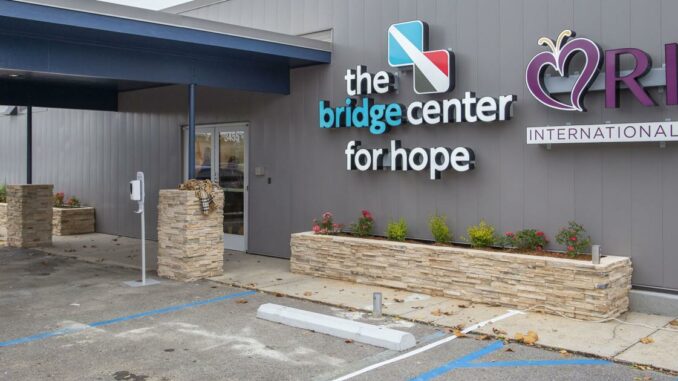
On Feb. 11, 2021, the Bridge Center for Hope opened its doors and became the first crisis center in Louisiana.
“Our license is 0001,” said Executive Director Charlotte Claiborne. “We’re the new thing, the new kids on the block.”
A little more than two years in, the center has served more than 6,000 patients. These are the lessons learned so far.
The Bridge Center provides a needed service
Historically, people arrested for nonviolent offenses and suffering from mental illnesses in Louisiana had only two options: expensive emergency rooms or parish prison. The Bridge Center was opened to serve as an immediate care facility for those experiencing a mental health crisis, as well as to alleviate pressure on police and emergency medical services. People can come in voluntarily or police can drop them off.
Claiborne said police are not necessarily trained to handle mental health issues, so they often bring people to emergency rooms, where wait times can be long and specialized psychiatric care isn’t always available. Or, they take them to parish prison.
“And that’s the last place people need to go,” she said.
Charlotte Claiborne, executive director of the The Bridge Center for Hope
Over the past three years, the number of calls to law enforcement and emergency medical services from people experiencing a mental health or substance abuse crisis has continued to rise. In 2022, Baton Rouge Police responded to 4,473 emotionally disturbed or psychiatric calls for service. Emergency Medical Services responded to 2,989, and the East Baton Rouge Sheriff’s Office responded to 404, according to the 2022 Bridge Center Annual Report.
Now, police can bring residents to the Bridge Center, where they will be seen and assessed immediately. The average time for law enforcement and first responders to drop someone off is 3.15 minutes, according to the center’s 2022 annual report.
Baton Rouge Police Chief Murphy Paul said the Bridge Center has been a big asset to his agency.
“It’s a resource that officers can rely on when dealing with daily mental health issues,” he said, adding that the wait time for officers is significantly less than at emergency rooms.

A secure screened in patio area in the medical detox unit during a tour after a ribbon cutting ceremony for The Bridge Center for Hope Tuesday, Dec. 15, 2020, in Baton Rouge, La. The psychiatric stabilization and detox facility was funded through a 1.5-mill property tax voters approved in December 2018.
“And at the emergency room, we might stay with them for hours, and on top of that they may make the decision not to admit them,” said Baton Rouge police spokesman Sgt. L’Jean McKneely. “At the Bridge Center, we are able to just drop them off and they take it from there.”
Most patients are voluntary walk-ins
While the center was imagined to relieve pressure on law enforcement and emergency medical services, in 2022, 75% of patients entered the facility on their own.
Claiborne said she is glad people in the community are learning about the center and feel comfortable coming in on their own, but also called it a “double-edged sword.”
“We’re doing well, but unfortunately we’re doing well because it means that many people need services. Is it a success in which it was designed to do? Yes,” she said.
Funding doesn’t match the services provided
Last year, RI International, the nonprofit provider that staffs the Bridge Center, did not renew contracts for 21 staff due to Medicaid funding issues. When the Bridge Center first opened, there was no dedicated funding for crisis services in Louisiana, so Medicaid rates for crisis services did not exist. The Louisiana Department of Health eventually implemented a crisis rate in 2022, but Claiborne said the rates are not as high as the center expected they would be, and not adequate, so RI International had to adjust.
“We didn’t lose any of the services being provided. We did not change the way that the front door operates. We did not and have not turned anyone away. The first unit that we received individuals into is still the same,” said Joy Brunson-Nsubuga, vice president of operations at RI International. “It was more about the capacity. At this point we are not in a position to expand the services.”
After the initial stabilization period, the Bridge Center works with local partners to find longer-term options for patients who need them, whether that’s a hospital, 28-day treatment program, sending a patient home with a family member, or finding an outpatient provider.
“It just depends on that person and their needs,” Claiborne said. “But our whole purpose is that we are short-term, not long-term. We will always be able to tell law enforcement or first responders yes.”
She said a capacity plan monitored throughout the day helps the center ensure it never gets to a point where it can’t see a new patient.

A room in the short term psychological observation unit area during a tour after a ribbon cutting ceremony for The Bridge Center for Hope Tuesday. Dec. 15, 2020, in Baton Rouge, La. The psychiatric stabilization and detox facility was funded through a 1.5-mill property tax voters approved in December 2018.
“To run that kind of a model, which is 24/7, 365 days a year, no wrong door, and always ready for the most acute patients, it takes a level of staffing that is not typical of an outpatient mental health clinic,” said Patrick Seiter, general counsel at Woman’s Hospital and a Bridge Center board member. “Medicaid reimbursement is built on a more typical model. When you compare what the reimbursement for crisis intervention is at the Bridge Center versus a hospital or emergency center, which receive much more funding, it’s just way out of whack.”
The Bridge Center is funded partly by a tax millage, passed in December 2018, that allows anyone 18 or older in East Baton Rouge to seek treatment at the facility free of charge. Of the 194,000 adults in Louisiana who did not receive mental health care in 2020, 41.8% did not because of cost, according to the National Alliance on Mental Health.
“Applause for the people of East Baton Rouge Parish for supporting this service,” Seiter said. “But the passing of the millage to support substance use disorder treatment and mental health crisis intervention services was not intended to replace Medicaid funding. It was intended to supplement it. If Medicaid steps up and pays at least the cost for the level of care provided, then we can truly expand access to people who don’t otherwise have it.”
The Louisiana Department of Health said it raised all Medicaid crisis rates to the maximum federally-allowed level on Dec. 1, 2022.
The mental health crisis in Louisiana is ongoing. In 2021, 32.5% of adults in the state reported symptoms of anxiety and/or depressive order, according to LDH’s 2023 business plan. In 2019, 21.2% of adults in Louisiana had a mental illness.
“This equates to about 1 in 5 Louisianan adults living with mental illness each year,” reads the report.
Yet crisis centers struggle to stay afloat. A crisis receiving center in St. Tammany Parish closed after nine months in operation because it was not financially sustainable.
“They didn’t have the dedicated tax to help them, and they couldn’t make it on the Medicaid rates implemented,” Claiborne said.
Brunson-Nsubuga said RI International has been asked to open additional centers, but has declined because it wouldn’t be sustainable.
Claiborne said she hopes the Louisiana Department of Health can work to pass legislation that would raise Medicaid rates to be on par with the services being offered, but in the meantime said the Bridge Center is not at capacity and she hopes people continue to see it as a resource.
“We’ve seen 6,000 people. What happens if we’re not here? They would have not gotten services, or they would have gone to the ER and it would cost more, or there would be overcrowding, or they would go to parish prison,” Claiborne said. “We can see more than what we’re seeing now. If more people were to come, we can handle it.”

Leave a Reply